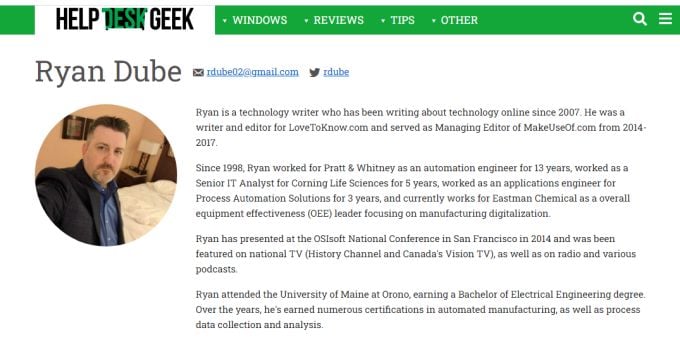You'll have new visitors stat
Launching a website is ridiculously easy these days. That probably explains why there are over 1.7 billion (and growing) websites on the internet today.
With so much content and products on the internet, how can you even get your site noticed? It’s like trying to get a single grain of sand noticed on a beach that’s miles long.

Thankfully, there are proven methods to stand out, and then increase website traffic rapidly once people realize your site exists.
1. Establish Your Authority
The first place people will look to learn about you when they visit your website is your About page.
About Page and Author Bio
That’s where you want to solidify the visitor’s trust in you as an expert in the field you’re publishing content about.

It’s also a good idea to include a small profile bio at the bottom of each article. This allows visitors to see your relevant expertise without having to click anywhere else on the site.

How does this help to increase website traffic? Several ways.
First, when visitors see that you’re actually an expert in the field, they’re more likely to share your post on social media and help draw in more traffic there. Secondly, one of the many signals Google uses in its search algorithm (for where your web pages will rank) is author reputation.
Author Credentials
While their earlier authorship initiative using Google+ was phased out, the reality is that the authority and credibility of an author makes sense as a signal for the value of any article. So we can be sure that Google uses author authority and credibility to adjust the value of any web page.
So include your credentials and experience relative to the page content anywhere and everywhere you can.
Social Media Presence
There is nothing quite as powerful at increasing website traffic quickly than getting a post to go viral on social media.
The best way to make this happen is to create an official Twitter presence for your site, and an official Facebook page as well.

If you have the time and resources to invest in it, you might also consider taking advantage of Pinterest, Instagram, and any other social networks you know well.
Once you’ve established your presence there, remember to engage, engage, and then engage some more. There is no better way to establish authority on a topic than being fully-engaged in that relevant community.

Don’t only post your blog posts or web pages whenever you publish something new. Remember to interact with other users. Follow people in your field. Reply to their comments. Retweet or repost what other people share.
Sometimes social media only provides a trickle of traffic to your site, but other times when you’ve posted something especially unique or interesting, it can easily go viral. That will send swarms of visitors to your site very quickly.
Offer Free Classes or Webinars
There are countless free platforms out there to create your own online courses or webinars. Take advantage of these and prove that you really are an expert in your field.
You can link to these courses on your website, and share them from social media. Make sure to include a link, at least in your course profile, to your website so people know where to find you.
Choose course topics to create that mirror the sorts of things you publish on your website. This way you could actually use examples or reading material from your site to bolster the course content.
Post on Quora
Quora is the site where you can find experts to answer any question you might have. Quora gets over 100 million monthly visitors. And the great thing about those visitors is that they’re highly interested in the kind of topics you publish on your site.
So this gives you two benefits. By posting answers on Quora as an expert, you gain credibility on those topics. At the same time, you can include your website in your profile, which can increase website traffic.

Again, this is another resource that does require time and effort on your part to take advantage of. So if you take this route, make sure you schedule time every week to visit the site and post responses to questions or comments.
2. Implement Common Sense SEO
Obviously, a big component of your traffic will come from Google Search. You don’t have to be an SEO expert to do a good job here, but you do need to follow basic SEO optimization tips to make sure you aren’t hurting your site’s chances of ranking well.
Here are a few of the most important items to take care of to optimize your site’s SEO.
- Choose a good domain name, preferably as short as possible and easy to remember.
- Set up the Title and Description for your site. WordPress provides fields for these.
- Configure your post slugs (URLs) to use the category and the title of the post. If you don’t use categories, then just include the title to make the URL as short and simple as possible.
- Create unique, quality content. Use SEO tools like WordTracker or SEMRush to find topics that a lot of people are searching for but have low competition (few sites on the web cover it).

- Use an SEO plugin if you use WordPress. These make sure the basic things like sitemaps and other technical issues are set up properly for the best site SEO.
- Hire experts to write content for you who have proven expertise and credentials on those topics. Make sure to include their profiles with the content.
- Install a CDN service like CloudFlare or Stackpath. These services store and cache some of your site’s content on servers local to your visitors, so things like pictures or scripts will download to their browsers more quickly.
- Install an SSL certificate on your site so that your URL starts with “HTTPS”. Google ranks secure sites higher than others.
If you implement all of these tips, you can be confident you’re doing everything you can to optimize your site for the best SEO. This will increase website traffic significantly.
3. Create YouTube Tutorials
YouTube has a tremendous audience. So, why not take advantage of that and drive some of that audience to your site by creating YouTube tutorials?
Once you’ve created these, include them in your website content for visitors who prefer to watch videos rather than read content to learn things.
Include a link to your site content in the YouTube video description, as well as a link to your site in your YouTube profile.
4. Write Medium Articles
Medium, the crowd-sourced article website, gets nearly 200 million visitors a month. It may seem counterintuitive to publish content on a site other than your own. However, publishing articles here establishes you as an expert.
You can mention the site or sites you run in your profile, and also sparingly link to your own site as a resource anywhere in your content.

Like Quora and YouTube, posting here builds up your reputation, has the potential to increase website traffic via links, and it also provides your site with backlinks from a highly ranked, authoritative domain.
5. Constantly Update Old Content
Outdated content just doesn’t usually rank as well as freshly published content. The key word here is “usually”. This will typically be the case if the content of the article itself is outdated and no longer accurate.
However, it’s not the case when that article is still accurate, and remains one of the best sources of information about the topic on the internet. To determine whether you should update old content to increase your website traffic, consider:

- Does the content accurately answer the query, and offer the most recent information?
- Is the formatting well optimized for SEO (good headers throughout, easily readable).
- Is there any new information missing from the original article?
- How well does the article already rank in Google Search results?
The bottom line is that if you’re already listed in the top spot in Google Search results, you probably don’t have to do much to the original article, unless the content is outdated.
6. Conduct Online Surveys on Hot Topics
If you really want to drive a Twitter or Facebook post viral, create a poll or a survey on a controversial topic.

Here’s the great thing about polls. They get people forwarding the poll to friends in order to achieve the final results they want. People come back to check results.
You can do this the easy way on Twitter by creating a new Tweet and then selecting the bar chart Poll icon.

Just enter the poll question, choices, and other details. Then Tweet it and wait for the responses. You can embed the Twitter poll on your website to further drive traffic to it (and responses).
The hope here is that people will also check your profile and learn about your site. However, if you want to drive more traffic, create your own custom poll and then post it to Twitter. Direct people to your site to view results. This will encourage people to bookmark your site so they can check it later.
7. Conduct Influencer Interviews
A final way to drive a great deal of traffic to your site is by reaching out to influencers on Twitter in the same field you publish content about. Reach out and ask about doing an interview.
When you publish an interview with an influencer who has a very large social media following, it helps both the influencer and your website.

What does the influencer get out of the interview?
- More credibility as an expert in their field
- Pride from having their interview published online
- Proof to their followers that they are in fact influential
- Free publicity
What does your site get out of the interview?
- Search traffic whenever anyone searches their name on Google
- Social traffic when the influencer shares a link to the interview
- Potentially more followers on your own official social media account
Interviews are a fantastic way to engage with the community and also get your site a much needed boost in traffic.




